Differentiated In-Row Soil Management in a High-Density Olive Orchard: Effects on Weed Control, Tree Growth and Yield, and Economic and Environmental Sustainability
Abstract
1. Introduction
2. Materials and Methods
2.1. Site and Experimental Setup
2.2. Measurements
2.3. Statistical Analysis
2.4. Life Cycle Assessment Methodology
2.5. Life Cycle Costing and the Eco-Efficiency Ratio
3. Results and Discussion
3.1. Weed Dynamics during the Trial
3.2. Residual Effect of Treatments on Weed Communities
3.3. Olive Tree Growth and Yield
3.4. Root Development
3.5. Environmental and Economic Assessment: The Eco-Efficiency Ratio
4. Conclusions
Author Contributions
Funding
Data Availability Statement
Acknowledgments
Conflicts of Interest
References
- Camposeo, S.; Ferrara, G.; Palasciano, M.; Godini, A. Varietal Behaviour According to The Superintensive Oliveculture Training System. Acta Hortic. 2008, 791, 271–274. [Google Scholar] [CrossRef]
- Marino, G.; Macaluso, L.; Marra, F.P.; Ferguson, L.; Marchese, A.; Campisi, G.; Volo, P.; Laudicina, V.A.; Caruso, T. Horticultural Performance of 23 Sicilian Olive Genotypes in Hedgerow Systems: Vegetative Growth, Productive Potential and Oil Quality. Sci. Hortic. 2017, 217, 217–225. [Google Scholar] [CrossRef]
- Lodolini, E.M.; de Iudicibus, A.; Lucchese, P.G.; Las Casas, G.; Torrisi, B.; Nicolosi, E.; Giuffrida, A.; Ferlito, F. Comparison of Canopy Architecture of Five Olive Cultivars in a High-Density Planting System in Sicily. Agriculture 2023, 13, 1612. [Google Scholar] [CrossRef]
- León, L.; de la Rosa, R.; Barranco, D.; Rallo, L. Breeding for Early Bearing in Olive. HortScience 2007, 42, 499–502. [Google Scholar] [CrossRef]
- Russo, G.; Vivaldi, G.A.; De Gennaro, B.; Camposeo, S. Environmental Sustainability of Different Soil Management Techniques in a High-Density Olive Orchard. J. Clean. Prod. 2015, 107, 498–508. [Google Scholar] [CrossRef]
- Vignozzi, N.; Agnelli, A.E.; Brandi, G.; Gagnarli, E.; Goggioli, D.; Lagomarsino, A.; Pellegrini, S.; Simoncini, S.; Simoni, S.; Valboa, G.; et al. Soil Ecosystem Functions in a High-Density Olive Orchard Managed by Different Soil Conservation Practices. Appl. Soil. Ecol. 2019, 134, 64–76. [Google Scholar] [CrossRef]
- Bombino, G.; Denisi, P.; Gómez, J.A.; Zema, D.A. Mulching as Best Management Practice to Reduce Surface Runoff and Erosion in Steep Clayey Olive Groves. Int. Soil Water Conserv. Res. 2021, 9, 26–36. [Google Scholar] [CrossRef]
- Prosdocimi, M.; Tarolli, P.; Cerdà, A. Mulching Practices for Reducing Soil Water Erosion: A Review. Earth Sci. Rev. 2016, 161, 191–203. [Google Scholar] [CrossRef]
- Las Casas, G.; Ciaccia, C.; Iovino, V.; Ferlito, F.; Torrisi, B.; Lodolini, E.M.; Giuffrida, A.; Catania, R.; Nicolosi, E.; Bella, S. Effects of Different Inter-Row Soil Management and Intra-Row Living Mulch on Spontaneous Flora, Beneficial Insects, and Growth of Young Olive Trees in Southern Italy. Plants 2022, 11, 545. [Google Scholar] [CrossRef]
- Metzidakis, I.; Martinez-Vilela, A.; Castro Nieto, G.; Basso, B. Intensive Olive Orchards on Sloping Land: Good Water and Pest Management Are Essential. J. Environ. Manag. 2008, 89, 120–128. [Google Scholar] [CrossRef]
- Simoni, S.; Caruso, G.; Vignozzi, N.; Gucci, R.; Valboa, G.; Pellegrini, S.; Palai, G.; Goggioli, D.; Gagnarli, E. Effect of Long-Term Soil Management Practices on Tree Growth, Yield and Soil Biodiversity in a High-Density Olive Agro-Ecosystem. Agronomy 2021, 11, 1036. [Google Scholar] [CrossRef]
- Lodolini, E.M.; Ciaccia, C. Inter-Row Weed Management in a Young High-Density Olive Orchard. Acta Hortic. 2022, 1354, 41–48. [Google Scholar] [CrossRef]
- Assirelli, A.; Ciaccia, C.; Giorgi, V.; Zucchini, M.; Neri, D.; Lodolini, E.M. An Alternative Tool for Intra-Row Weed Control in a High-Density Olive Orchard. Agronomy 2022, 12, 605. [Google Scholar] [CrossRef]
- Hammermeister, A.M. Organic Weed Management in Perennial Fruits. Sci. Hortic. 2016, 208, 28–42. [Google Scholar] [CrossRef]
- Márquez-García, F.; González-Sánchez, E.J.; Castro-García, S.; Ordóñez-Fernández, R. Improvement of Soil Carbon Sink by Cover Crops in Olive Orchards under Semiarid Conditions. Influ. Type Soil Weed. Span. J. Agric. Res. 2013, 11, 335. [Google Scholar] [CrossRef]
- Granatstein, D.; Kupferman, E. Sustainable horticulture in fruit production. Acta Hortic. 2008, 767, 295–308. [Google Scholar] [CrossRef]
- Neri, D.; Zucchini, M.; Giorgi, V. Weed Management in Organic Orchards with Strawberry Species as Living Mulch. Acta Hortic. 2022, 1354, 49–56. [Google Scholar] [CrossRef]
- Sportelli, M.; Frasconi, C.; Gagliardi, L.; Fontanelli, M.; Raffaelli, M.; Sbrana, M.; Antichi, D.; Peruzzi, A. Testing of Roller-Crimper-and-Undercutting-Blade-Equipped Prototype for Plants Termination. AgriEngineering 2023, 5, 182–192. [Google Scholar] [CrossRef]
- Måge, F. Black Plastic Mulching, Compared to Other Orchard Soil Management Methods. Sci. Hortic. 1982, 16, 131–136. [Google Scholar] [CrossRef]
- Schonbeck, M. Synthetic Mulching Materials for Weed Management. Virginia Association for Biological Farming. (Elektronski Vir). 2012. Available online: https://eorganic.org/node/4872 (accessed on 8 August 2024).
- Kasirajan, S.; Ngouajio, M. Polyethylene and Biodegradable Mulches for Agricultural Applications: A Review. Agron. Sustain. Dev. 2012, 32, 501–529. [Google Scholar] [CrossRef]
- Tarara, J.M. Microclimate Modification with Plastic Mulch. HortScience 2000, 35, 169–180. [Google Scholar] [CrossRef]
- Torrisi, B.; Allegra, M.; Amenta, M.; Gentile, F.; Rapisarda, P.; Fabroni, S.; Ferlito, F. Physico-Chemical and Multielemental Traits of Anaerobic Digestate from Mediterranean Agro-Industrial Wastes and Assessment as Fertiliser for Citrus Nurseries. Waste Manag. 2021, 131, 201–213. [Google Scholar] [CrossRef] [PubMed]
- Hostetler, G.L.; Merwin, I.A.; Brown, M.G.; Padilla-Zakour, O. Influence of Undervine Floor Management on Weed Competition, Vine Nutrition, and Yields of Pinot Noir. Am. J. Enol. Vitic. 2007, 58, 421–430. [Google Scholar] [CrossRef]
- Żelazny, W.R.; Licznar-Małańczuk, M. Soil Quality and Tree Status in a Twelve-Year-Old Apple Orchard under Three Mulch-Based Floor Management Systems. Soil. Tillage Res. 2018, 180, 250–258. [Google Scholar] [CrossRef]
- Merwin, I.A.; Rosenberger, D.A.; Engle, C.A.; Rist, D.L.; Fargione, M. Comparing Mulches, Herbicides, and Cultivation as Orchard Groundcover Management Systems. Horttechnology 1995, 5, 151–158. [Google Scholar] [CrossRef]
- Zucconi, F. Nuove Tecniche per i Frutteti: Fisiologia e Metodi Innovativi Nell’allevamento Dei Fruttiferi; Edagricole: Bologna, Italy, 2003; ISBN 9788850648092. [Google Scholar]
- Gucci, R.; Caruso, G.; Bertolla, C.; Urbani, S.; Taticchi, A.; Esposto, S.; Servili, M.; Sifola, M.I.; Pellegrini, S.; Pagliai, M.; et al. Changes of Soil Properties and Tree Performance Induced by Soil Management in a High-Density Olive Orchard. Eur. J. Agron. 2012, 41, 18–27. [Google Scholar] [CrossRef]
- Adewale, C.; Reganold, J.P.; Higgins, S.; Evans, R.D.; Carpenter-Boggs, L. Agricultural Carbon Footprint Is Farm Specific: Case Study of Two Organic Farms. J. Clean. Prod. 2019, 229, 795–805. [Google Scholar] [CrossRef]
- Mittal, J.P.; Dhawan, K.C.; Thyagraj, C.R. Energy Scenario of Castor Crop under Dryland Agriculture of Andhra Pradesh. Energy Convers. Manag. 1991, 32, 425–430. [Google Scholar] [CrossRef]
- Pari, L.; Suardi, A.; Stefanoni, W.; Latterini, F.; Palmieri, N. Environmental and Economic Assessment of Castor Oil Supply Chain: A Case Study. Sustainability 2020, 12, 6339. [Google Scholar] [CrossRef]
- Palmieri, N.; Suardi, A.; Alfano, V.; Pari, L. Circular Economy Model: Insights from a Case Study in South Italy. Sustainability 2020, 12, 3466. [Google Scholar] [CrossRef]
- IUSS Working Group WRB. World Reference Base for Soil Resources 2014; Update 2015. Reports no.106; FAO: Rome, Italy, 2015; ISBN 978-92-5-108369-7. Available online: http://www.fao.org/3/a-i3794e.pdf (accessed on 8 August 2024).
- Magurran, A.E. Measuring Biological Diversity; Wiley-Blackwell: Hoboken, NJ, USA, 2013; ISBN 978-1-118-68792-5. [Google Scholar]
- Regent Instruments Inc. WinRHIZO™ Analysis of Washed Roots and Arabidopsis Seedlings. Copyright© 1991–2024. Available online: https://regent.qc.ca (accessed on 8 August 2024).
- SAS Institute Inc. JMP®, Version 14.0; SAS Institute Inc.: Cary, NC, USA, 1989.
- StatSoft, Inc. STATISTICA™ (Data Analysis Software System), Version 7.1; StatSoft, Inc.: Tulsa, OK, USA, 2007.
- ISO 14040:2006; Environmental Management—Life Cycle Assessment—Principles and Framework. International Organization for Standardization: Geneva, Switzerland, 2006.
- ISO 14044:2006; Environmental Management—Life Cycle Assessment—Requirements and Guidelines. International Organization for Standardization: Geneva, Switzerland, 2006.
- SIMAPRO, LCA Software for Informed Change-Makers. 2022. Available online: https://simapro.com/ (accessed on 6 February 2023).
- Bamber, N.; Jones, M.; Nelson, L.; Hannam, K.; Nichol, C.; Pelletier, N. Life Cycle Assessment of Mulch Use on Okanagan Apple Orchards: Part 1—Attributional. J. Clean. Prod. 2020, 267, 121960. [Google Scholar] [CrossRef]
- Brandão, M.; Clift, R.; Basson, L. A Life-Cycle Approach to Characterising Environmental and Economic Impacts of Multifunctional Land-Use Systems: An Integrated Assessment in the UK. Sustainability 2010, 2, 3747–3776. [Google Scholar] [CrossRef]
- ISMEA, Istituto Di Servizi per Il Mercato Agricolo Alimentare (ISMEA). 2022. Available online: https://www.ismea.it/flex/cm/pages/ServeBLOB.php/L/IT/IDPagina/6 (accessed on 6 February 2023).
- Van Passel, S.; Lepoutre, J.; Nevens, F.; Van Huylenbroeck, G.; Mathijs, E. Economische Duurzaamheid en Toegevoegde Waarde: Een Eerste Aanzet Op Basis van Macro-Economische Gegevens; Stedula Publicatie: Gontrode, Belgium, 2004; ISBN 90-77547-09-6. [Google Scholar]
- World Business Council for Sustainable Development (WBCSD). Eco-Efficiency Learning Module. 2006. Available online: https://docs.wbcsd.org/2006/08/EfficiencyLearningModule.pdf (accessed on 8 August 2024).
- Ferrara, G.; Fracchiolla, M.; Chami, Z.A.; Camposeo, S.; Lasorella, C.; Pacifico, A.; Aly, A.; Montemurro, P. Effects of Mulching Materials on Soil and Performance of Cv. Nero Di Troia Grapevines in the Puglia Region, Southeastern Italy. Am. J. Enol. Vitic. 2012, 63, 269–276. [Google Scholar] [CrossRef]
- Palese, A.M.; Nuzzo, V.; Dichio, B.; Celano, G.; Romano, M.; Xiloyannis, C. The Influence of Soil Water Content on Root Density in Young Olive Trees. Acta Hortic. 2000, 537, 329–336. [Google Scholar] [CrossRef]
- Masmoudi-Charfi, C.; Masmoudi, M.; Ben Mechlia, N. Root Distribution in Young Olive Trees (Olea europaea Cv. Chétoui) and Agronomic Application. Adv. Hortic. Sci. 2013, 25, 112–122. [Google Scholar] [CrossRef]
- Lodolini, E.M.; de Iudicibus, A.; Lucchese, P.G.; Zucchini, M.; Crescenzi, S.; Pacella, M.; Giorgi, V.; Neri, D. Canopy and Root Growth of Young Olive Trees in a High-Density Orchard. Acta Hortic. 2023, 1366, 253–260. [Google Scholar] [CrossRef]
- Zadworny, M.; Eissenstat, D.M. Contrasting the Morphology, Anatomy and Fungal Colonization of New Pioneer and Fibrous Roots. New Phytol. 2011, 190, 213–221. [Google Scholar] [CrossRef]
- Pari, L.; Alexopoulou, E.; Stefanoni, W.; Latterini, F.; Cavalaris, C. The Eco-Efficiency of Castor Supply Chain: A Greek Case Study. Agriculture 2022, 12, 206. [Google Scholar] [CrossRef]
- Houle, G.; Babeux, P. Fertilizing and Mulching Influence on the Performance of Four Native Woody Species Suit-able for Revegetation in Subarctic Quebec. Can. J. For. Res. 1994, 24, 2342–2349. [Google Scholar] [CrossRef]
- Neilsen, G.H.; Hogue, E.J.; Forge, T.; Neilsen, D. Surface Application of Mulches and Biosolids Affect Orchard Soil Properties after 7 Years. Can. J. Soil Sci. 2003, 83, 131–137. [Google Scholar] [CrossRef]
- Nemecek, T.; Dubois, D.; Huguenin-Elie, O.; Gaillard, G. Life cycle assessment of Swiss farming systems: I. Integrated and organic farming. Agric. Syst. 2011, 104, 217–232. [Google Scholar] [CrossRef]
- Iqbal, R.; Raza, M.A.S.; Valipour, M.; Saleem, M.F.; Zaheer, M.S.; Ahmad, S.; Toleikiene, M.; Haider, I.; Aslam, M.U.; Nazar, M.A. Potential Agricultural and Environmental Benefits of Mulches—A Review. Bull. Natl. Res. Cent. 2020, 44. [Google Scholar] [CrossRef]
- Lightfoot, D.R. Morphology and Ecology of Lithic-Mulch Agriculture. Geogr. Rev. 1994, 84, 172–185. [Google Scholar] [CrossRef]
- Ngouajio, M.; McGiffen, M.E. Sustainable Vegetable Production: Effects of Cropping Systems on Weed and Insect Population Dynamics. In Proceedings of the XXVI International Horticultural Congress: Sustainability of Horticultural Systems in the 21st Century, Toronto, ON, Canada, 11–17 August 2002; Volume 638, pp. 77–83. [Google Scholar] [CrossRef]
- Lamont, W.J. Plastics: Modifying the Microclimate for the Production of Vegetable Crops. Horttechnology 2005, 15, 477–481. [Google Scholar] [CrossRef]
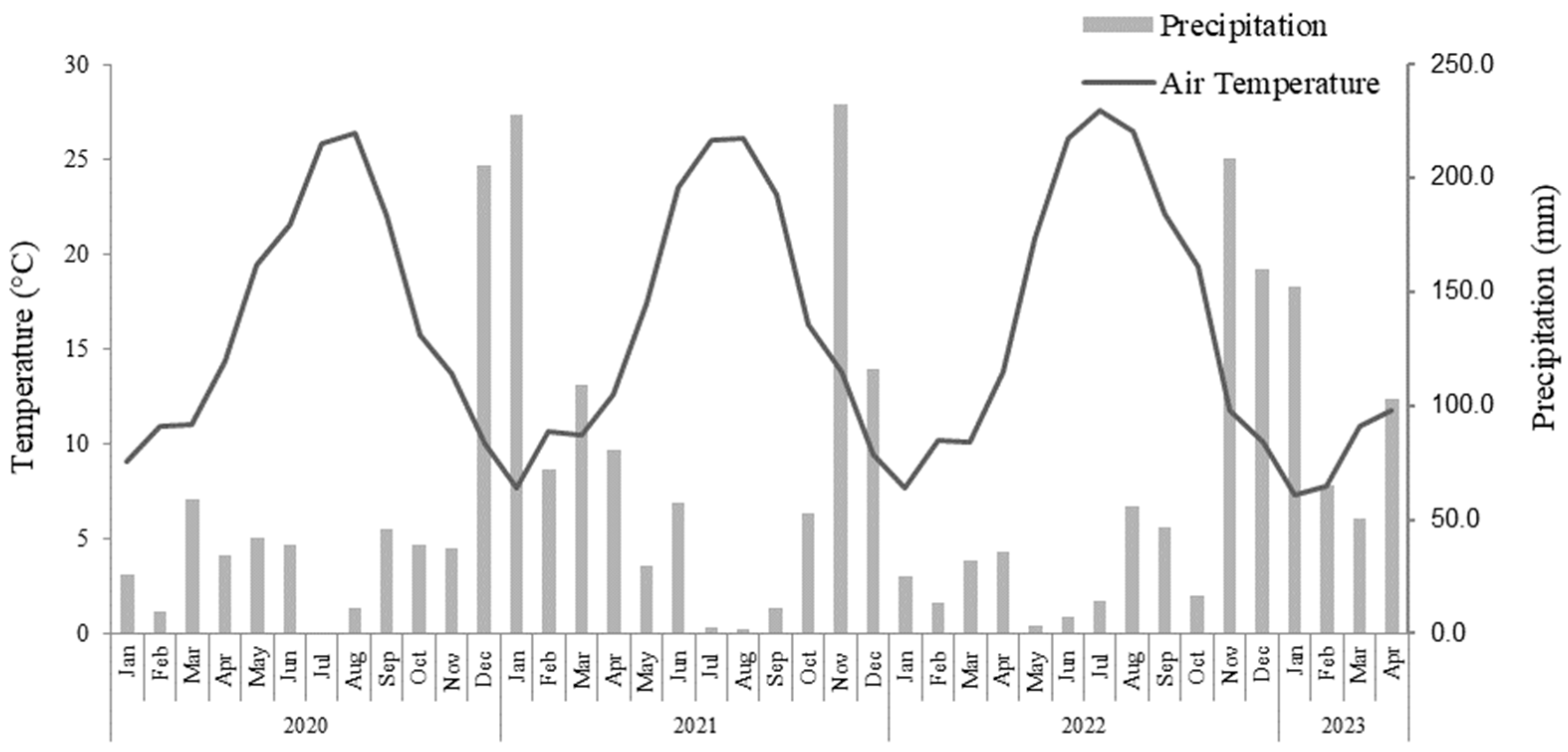
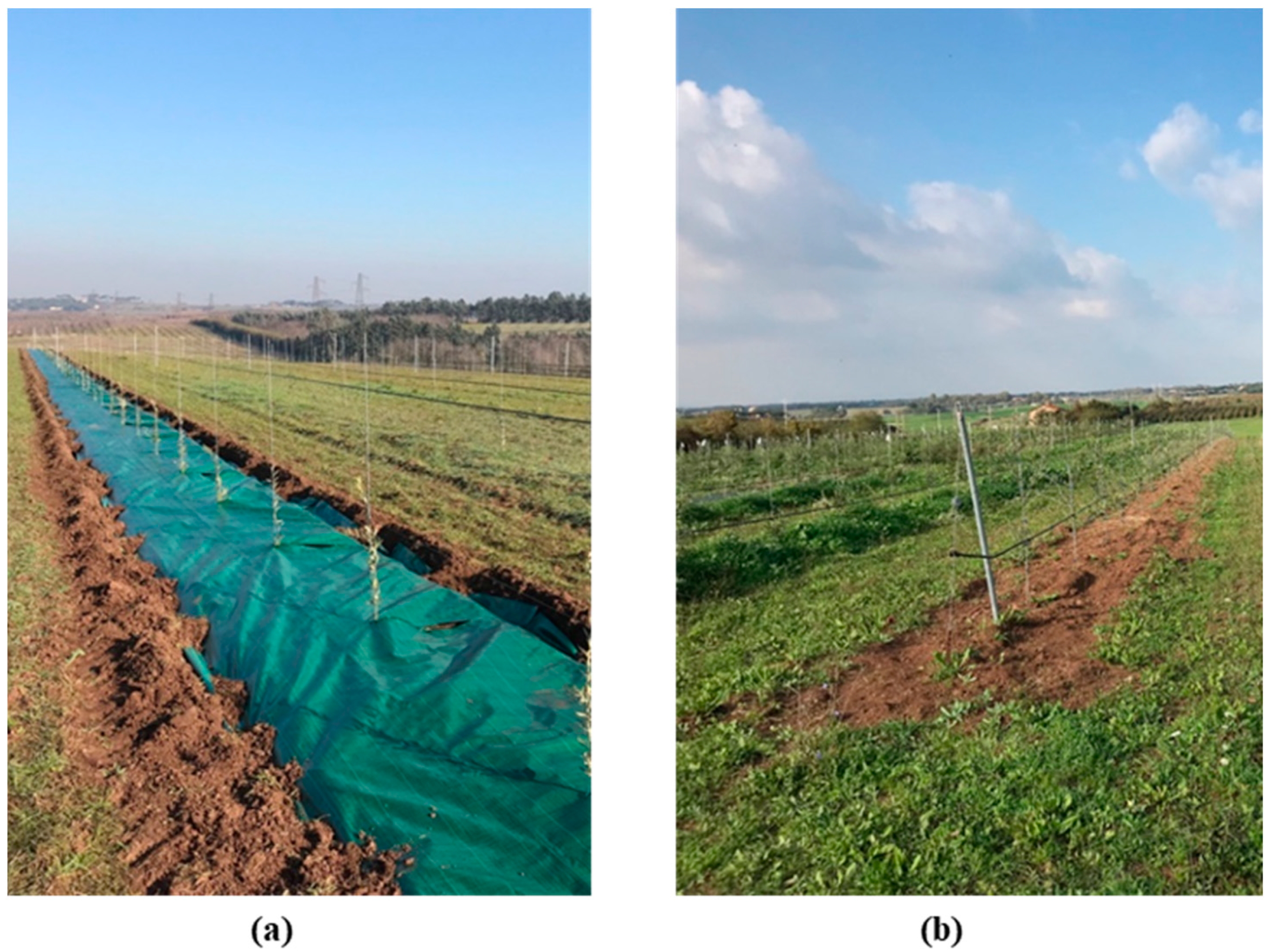
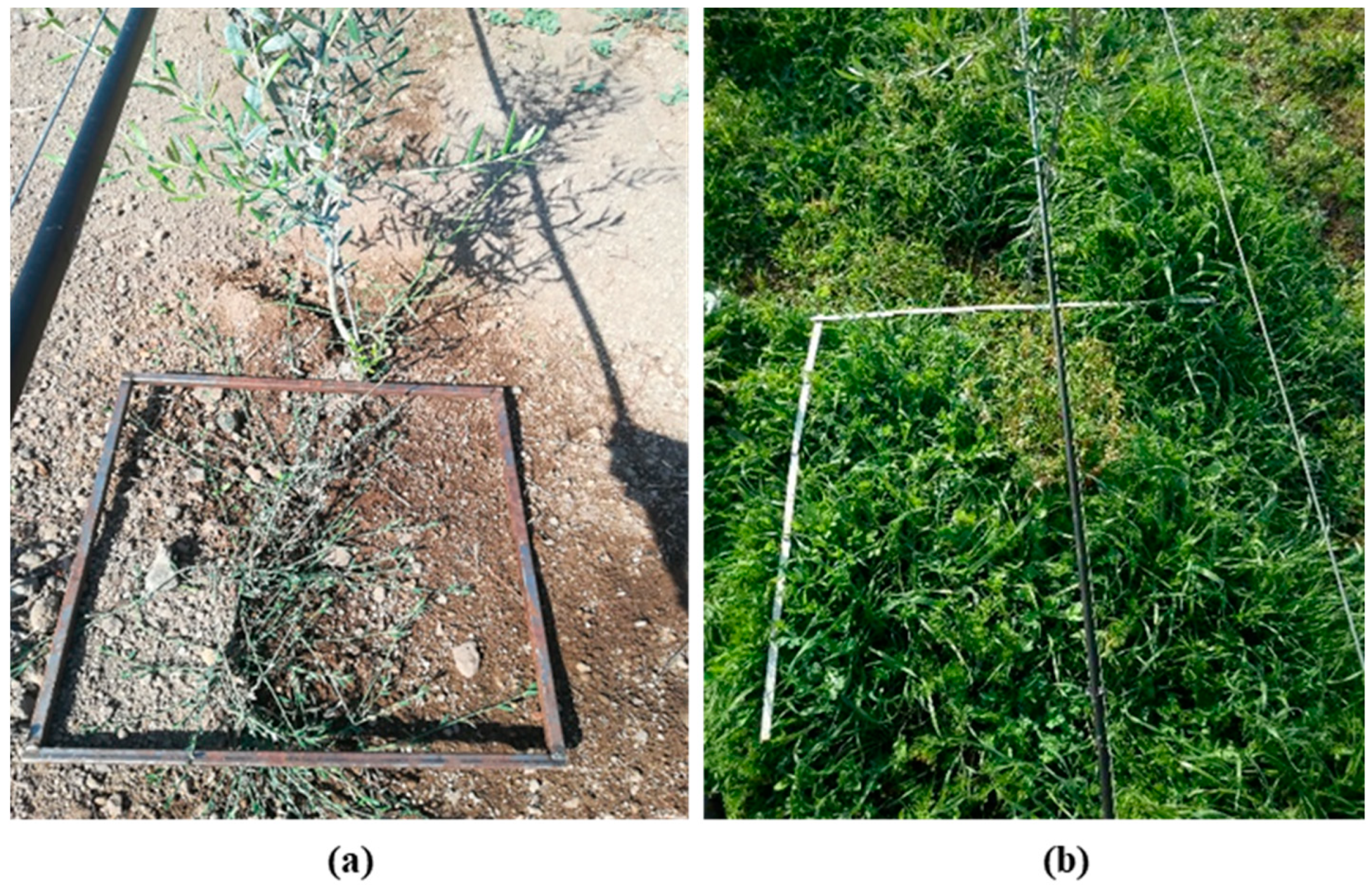
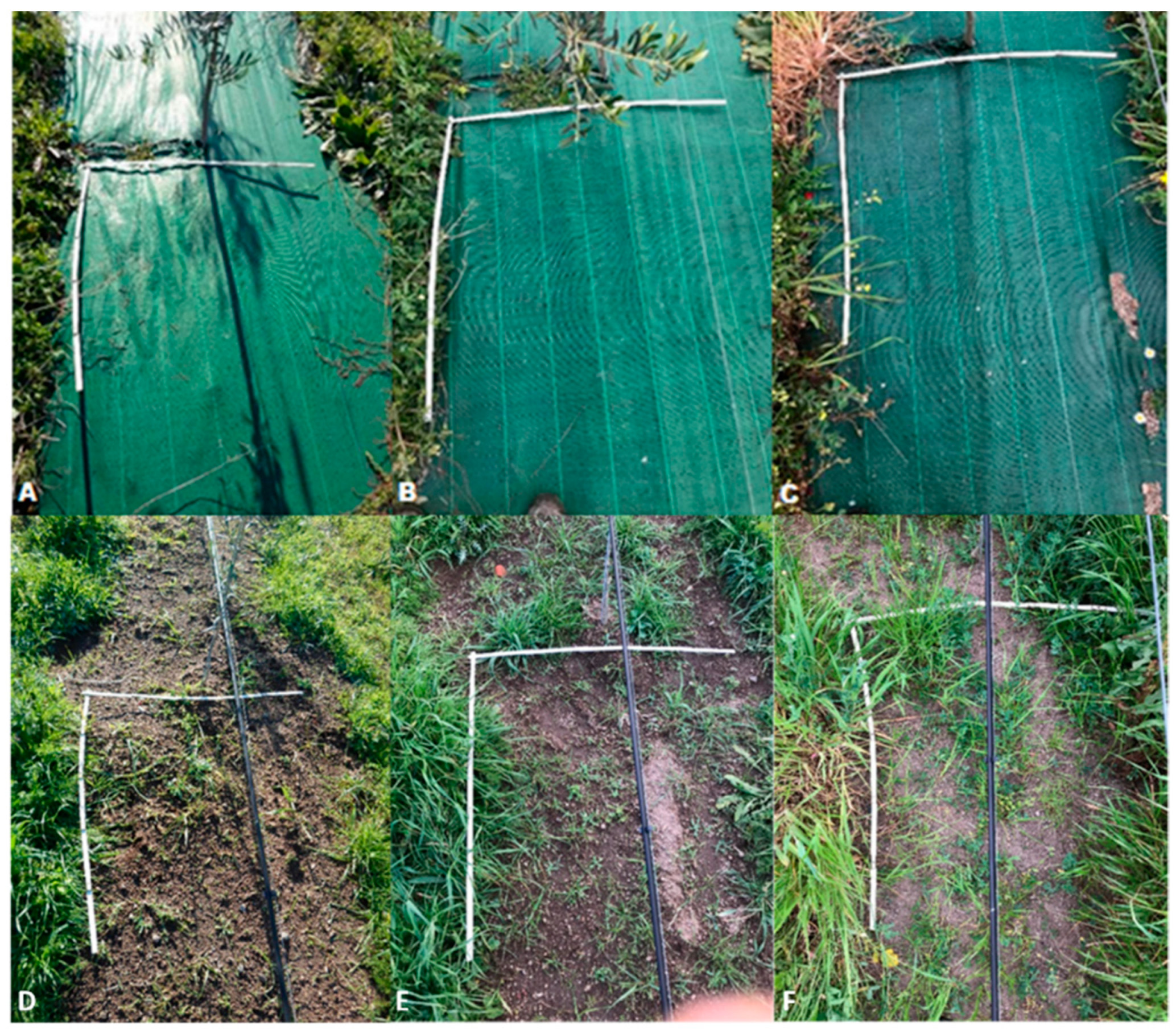

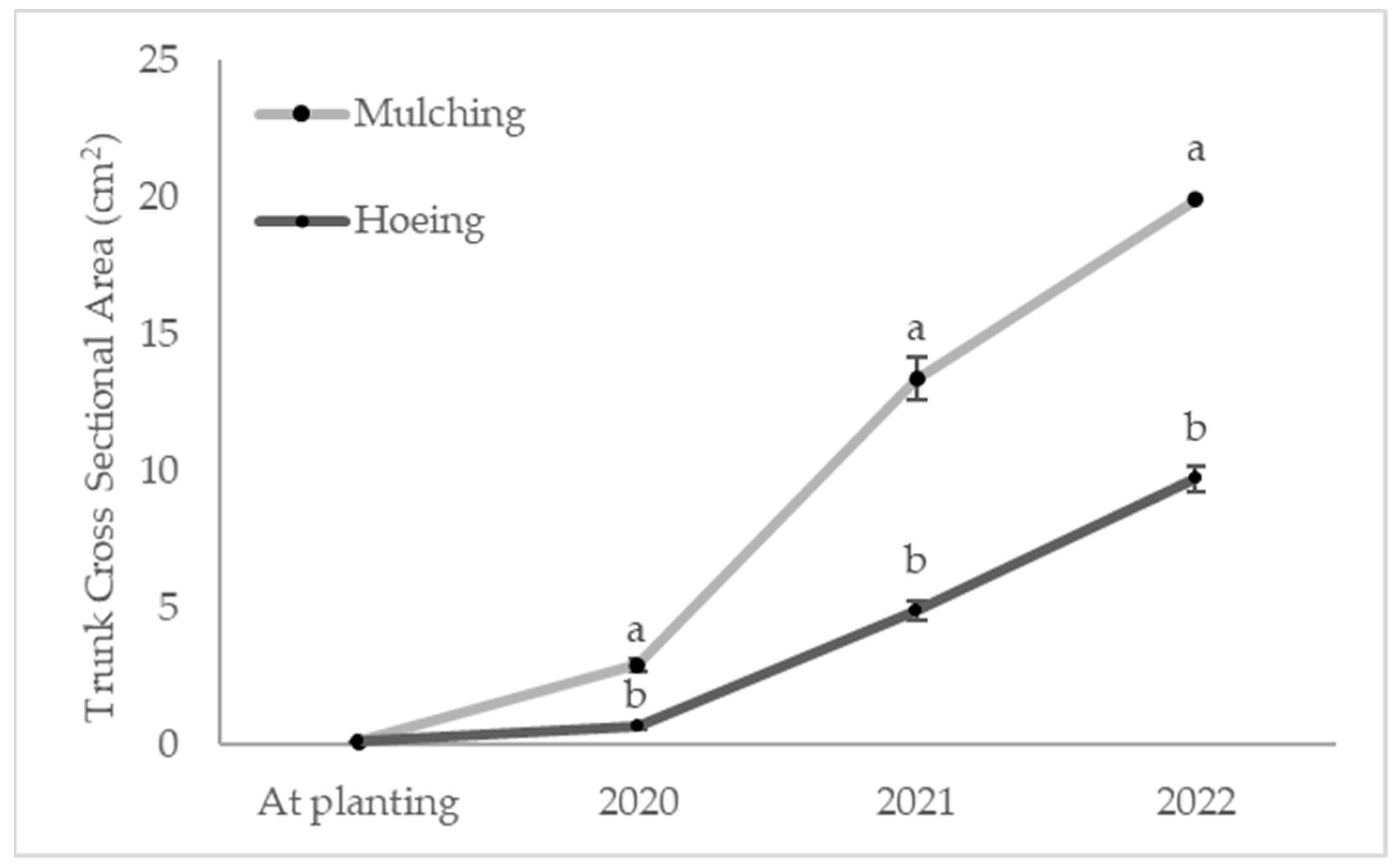
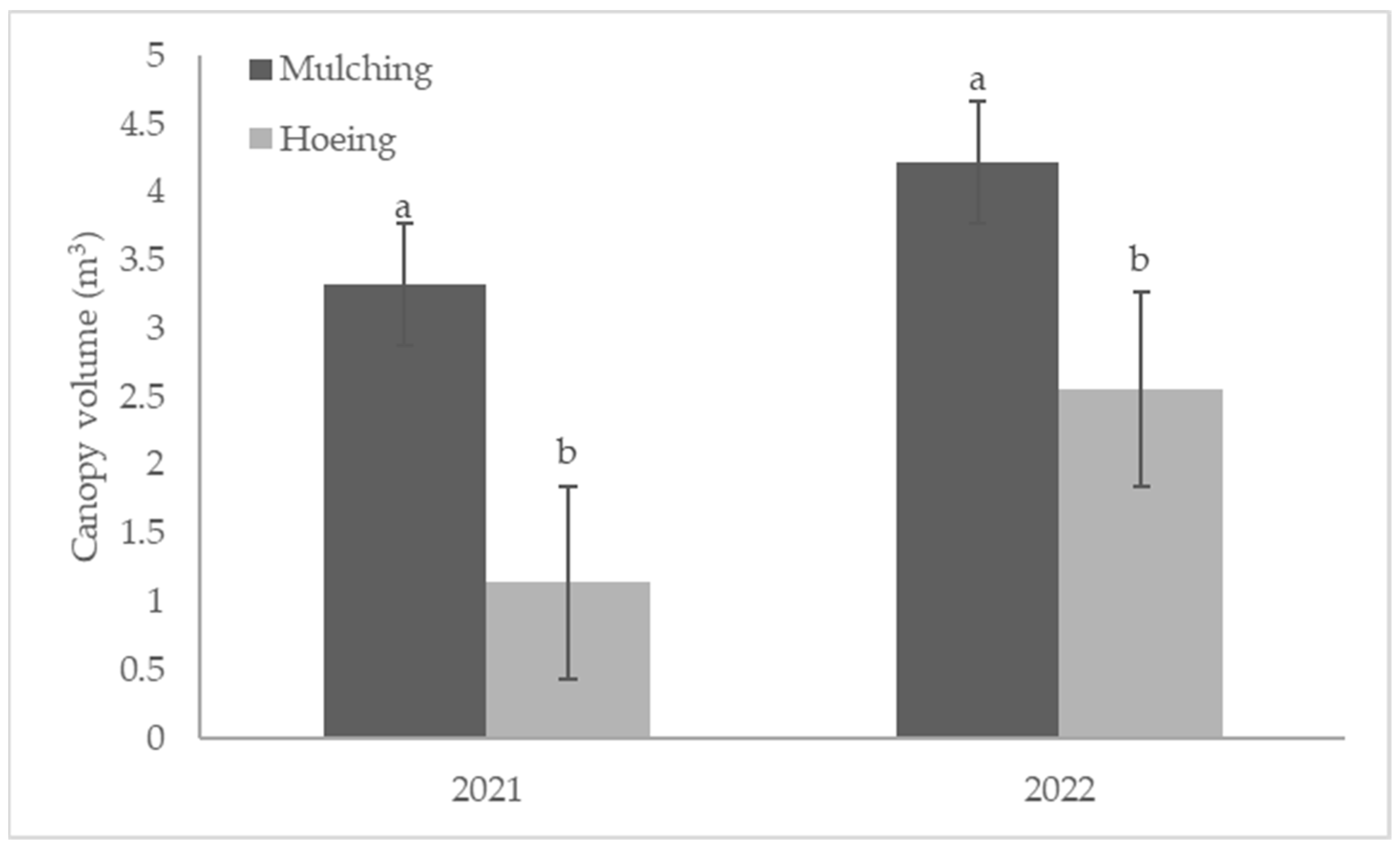
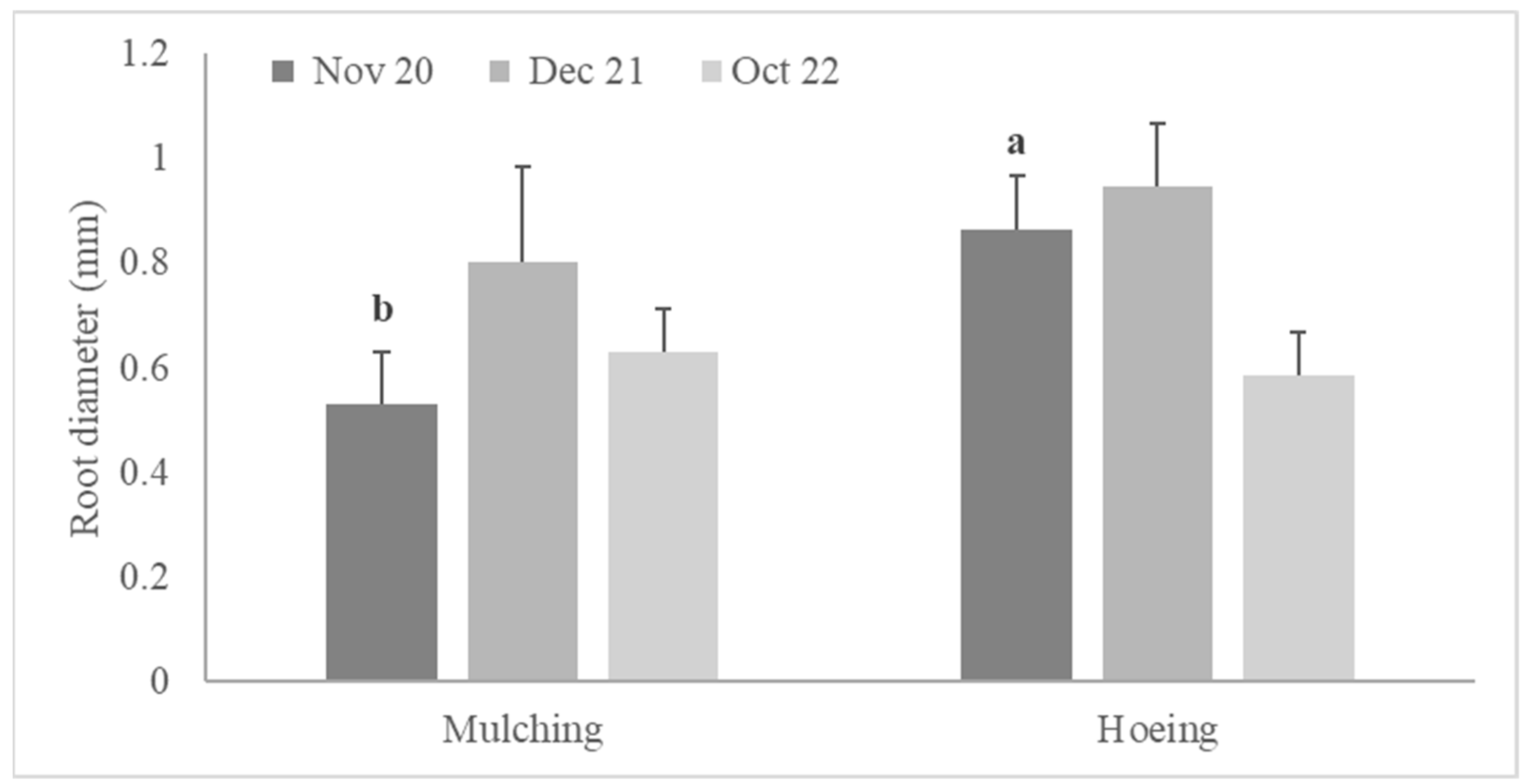

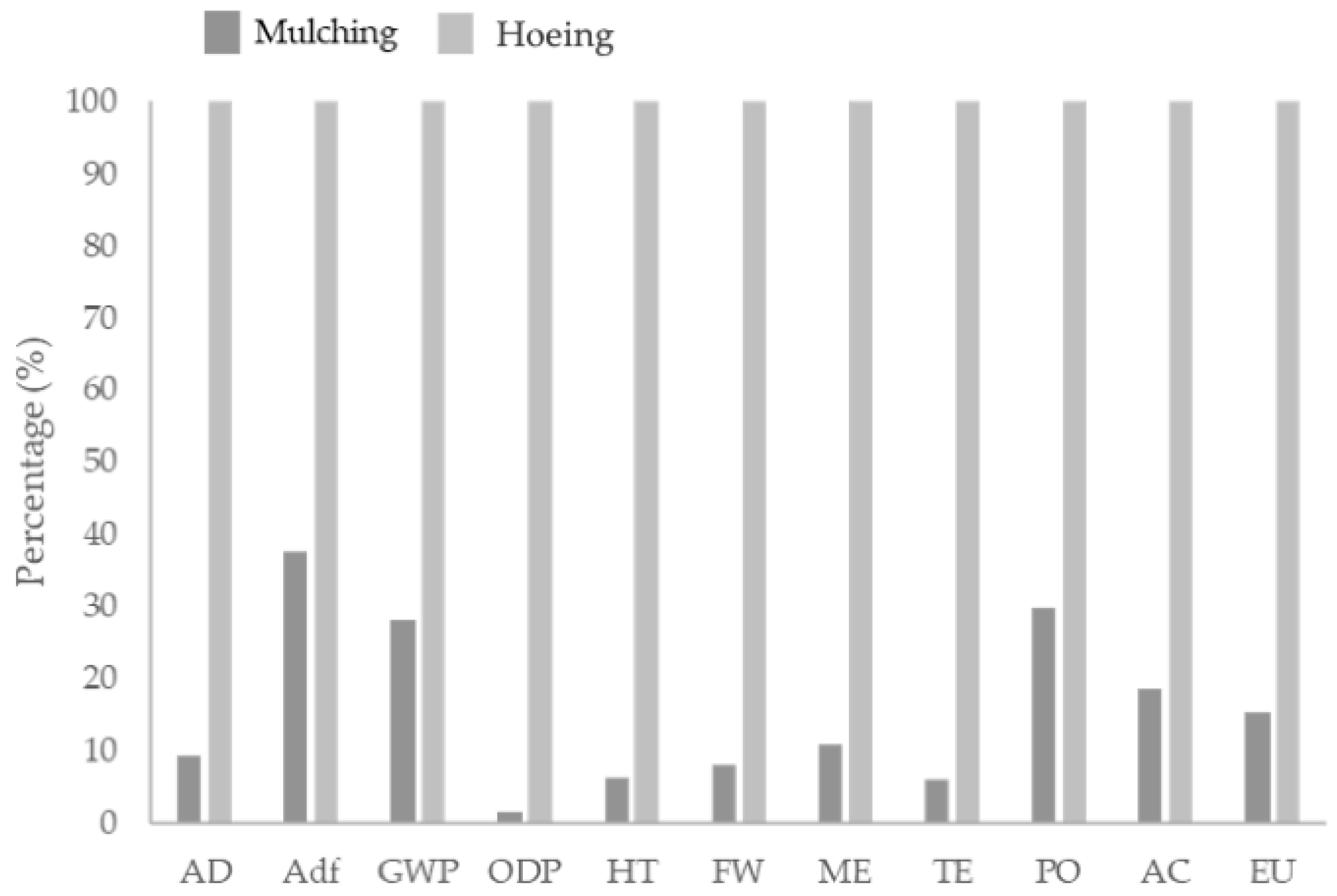
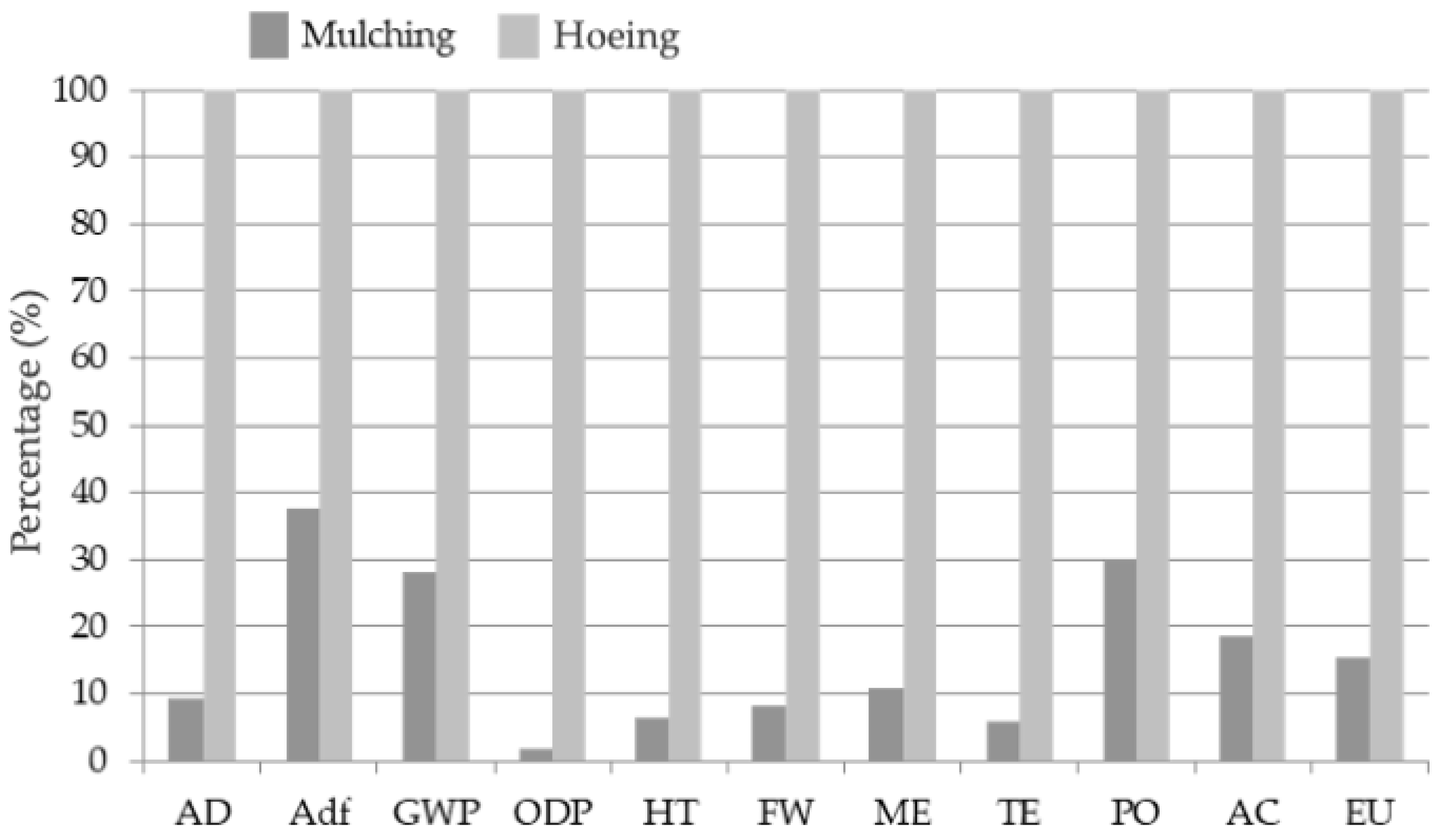
| Parameter | Measurement Date | Repetitions per Treatment |
|---|---|---|
| Weed evolution | Sept 2020 Nov 2020 Dec 2020 Jan 2021 Apr 2021 Feb 2023 (residual effect) March 2023 (residual effect) | 9 positions along each row (treatment) |
| Tree and canopy biometrics (height, widths, volume, TCSA) | Nov 2019 Oct 2020 Dec 2021 Oct 2022 | 30 trees along each row (treatment) |
| Fruit yield | Nov 2021 Oct 2022 | 30 trees along each row (treatment) |
| Root development (RLD, diameter) | Nov 2020 Dec 2021 Oct 2022 | 8 samples along each row (treatment) |
| Mulching | Hoeing | |||||||||||
|---|---|---|---|---|---|---|---|---|---|---|---|---|
| Agricultural Operation | Mulching | Cloth Removal | I Phase | II Phase | III Phase | IV Phase | V Phase | VI Phase | VII Phase | VIII Phase | IX Phase | X Phase |
| Tractor power (kW) | 50 | 50 | 50 | 50 | 50 | 50 | 50 | 50 | 50 | 50 | 50 | 50 |
| Tractor weight (kg) | 1800 | 1800 | 1800 | 1800 | 1800 | 1800 | 1800 | 1800 | 1800 | 1800 | 1800 | 1800 |
| Fuel or electricity consumption (l ha−1) | 9.00 | 9.00 | 9.00 | 9.00 | 9.00 | 9.00 | 9.00 | 9.00 | 9.00 | 9.00 | 9.00 | 9.00 |
| Lubricant consumption (l ha−1) | 0.05 | 0.05 | 0.05 | 0.05 | 0.05 | 0.05 | 0.05 | 0.05 | 0.05 | 0.05 | 0.05 | 0.05 |
| Lifetime (h ha−1) | 10,000 | 10,000 | 10,000 | 10,000 | 10,000 | 10,000 | 10,000 | 10,000 | 10,000 | 10,000 | 10,000 | 10,000 |
| Machinery used (type) | Roll it out | Harrow | Tillage | Tillage | Tillage | Tillage | Tillage | Tillage | Tillage | Tillage | Tillage | Tillage |
| Machinery power (kW) | - | - | - | - | - | - | - | - | - | - | ||
| Weight machineries (kg) | 600 | 300 | 4500 | 4500 | 4500 | 4500 | 4500 | 4500 | 4500 | 4500 | 4500 | 4500 |
| Lifetime (h) | 15,000 | 5000 | 7000 | 7000 | 7000 | 7000 | 7000 | 7000 | 7000 | 7000 | 7000 | 7000 |
| Product utilized (type) | Cloth | - | - | - | - | - | - | - | - | - | - | - |
| Quantity (kg ha−1) | 1050 | |||||||||||
| Product utilized (type) | Urea (N46) | Urea (N 46) | Urea (N 46) | Urea (N 46) | ||||||||
| Quantity (kg ha−1) | 20 | - | - | - | 30 | - | - | 30 | - | - | 30 | - |
| Total Cover (%) | R | e | Perennials (%) | ||
|---|---|---|---|---|---|
| Before hoeing (Nov 2020) | |||||
| Hoeing | 100.00 | 6.44 | 0.82 | 19.4 | |
| 0 DAT (Nov 2020) | |||||
| Hoeing | 0.00 | - | - | - | |
| 35 DAT (Dec 2020) | |||||
| Hoeing | 9.67 | 4.70 | 0.85 | 19.15 | |
| 69 DAT (Jan 2021) | |||||
| Hoeing | 14.0 | 4.50 | 0.89 | 14.97 | |
| 147 DAT (Apr 2021) | |||||
| Hoeing | 37.6 | 7.5 | 0.87 | 8.21 |
| 10 February 2023 | 21 March 2023 | |||||||
|---|---|---|---|---|---|---|---|---|
| Hoeing | Mulching | Chopping | p | Hoeing | Mulching | Chopping | p | |
| TOT cov (%) | 90.6 b | 12.0 c | 96.8 b | 0.000 | 86.9 a | 16.3 b | 97.8 a | 0.000 |
| R | 15 a | 11 b | 12 ab | 0.009 | 18 a | 13 b | 14 b | 0.003 |
| e | 0.80 b | 0.94 a | 0.73 b | 0.000 | 0.80 b | 0.93 a | 0.71 c | 0.000 |
| Grass-like (%) | 19.5 a | 16.1 ab | 7.6 b | 0.031 | 34.6 a | 15.7 ab | 6.5 b | 0.004 |
| N-fixing (%) | 1.8 b | 10.7 a | 1.6 b | 0.000 | 5.3 b | 23.2 a | 4.3 b | 0.000 |
| PRN (%) | 12.0 b | 23.4 a | 24.7 a | 0.032 | 14.1 b | 32.9 a | 8.13 b | 0.001 |
| CH (m) | 0.47 | 0.49 | 0.48 | 0.952 | 0.50 a | 0.46 ab | 0.36 b | 0.004 |
| SW (g) | 3.59 | 2.11 | 1.56 | 0.238 | 2.79 a | 1.98 b | 1.44 b | 0.027 |
| SLA | 26.5 a | 25.2 a | 21.8 b | 0.005 | 25.9 ab | 26.7 a | 24.0 b | 0.006 |
| Slq (%) | / | / | / | / | 64.4 a | 49.5 b | 52.5 ab | 0.032 |
| 10 February 2023 | 21 March 2023 | |||||||
|---|---|---|---|---|---|---|---|---|
| F1 | F2 | F3 | F4 | F1 | F2 | F3 | F4 | |
| Variance | 31.31% | 25.46% | 16.64% | 12.56% | 41.49% | 20.29% | 14.65% | 10.00% |
| Tot cov | 0.857878 | 0.055373 | −0.424366 | −0.036035 | 0.888633 | 0.264174 | 0.158691 | −0.052396 |
| R | 0.070485 | 0.080039 | −0.819350 | 0.483757 | 0.164944 | 0.745661 | 0.196750 | 0.415940 |
| e | −0.914179 | 0.084359 | −0.181648 | 0.039881 | −0.856372 | 0.020949 | −0.223265 | 0.128304 |
| Grass-like | −0.463663 | 0.520483 | −0.460866 | −0.085255 | −0.076925 | 0.684540 | −0.567162 | 0.231484 |
| N-fixing | −0.848083 | −0.120901 | 0.245830 | 0.113716 | −0.878857 | −0.132469 | 0.006845 | −0.167181 |
| PRN | −0.315697 | −0.839283 | −0.207437 | −0.012275 | −0.878000 | −0.179524 | 0.251005 | 0.233256 |
| CH | −0.295044 | −0.688183 | −0.492588 | −0.274109 | −0.484445 | 0.297194 | 0.699256 | 0.270312 |
| SW | −0.064804 | 0.348586 | −0.221271 | −0.880463 | −0.174224 | 0.563539 | 0.430597 | −0.638599 |
| SLA | −0.340278 | 0.830625 | −0.074596 | 0.151707 | ||||
| Tree Height at Planting (cm) | Tree Height at Oct 2020 (cm) | Tree Height at Dec 2021 (cm) | Tree Height at Oct 2022 (cm) | |
|---|---|---|---|---|
| Mulching | 61.4 ± 2.34 | 130.4 ± 2.65 a | 207.0 ± 3.08 a | 239.5 ± 3.10 a |
| Hoeing | 60.2 ± 1.96 | 99.9 ± 3.51 b | 173.2 ± 4.28 b | 215.8 ± 4.78 b |
| 2nd Year after Planting (2021) | 3rd Year after Planting (2022) | |||
|---|---|---|---|---|
| Fruit Yield per Tree (kg) | Number of Fruits per Tree | Fruit Yield per Tree (kg) | Number of Fruits per Tree | |
| Mulching | 0.30 ± 0.09 a | 139.0 ± 42.3 a | 5.84 ± 0.40 a | 2904.3 ± 242.4 a |
| Hoeing | 0.05 ± 0.02 b | 24.5 ± 8.90 b | 2.46 ± 0.27 b | 1085.6 ± 139.9 b |
| Environmental Impact | Units | Mulching | Hoeing |
|---|---|---|---|
| Gross Revenue (EUR/ha−1) | (EUR/FU) | 2.250 | 2.100 |
| Total costs (EUR/ha−1) | (EUR/FU) | 1.703 | 1.750 |
| Total GVA (EUR/ha−1) | (EUR/FU) | 547 | 350 |
| GWP (kg CO2eq/ha−1) | (kg CO2eq/1 ha−1) | 200 | 266 |
| The eco-efficiency ratio | (€/kg CO2eq) | 2.73 | 1.32 |
| Sensitivity results | |||
| Gross Revenue (EUR/Mg−1) | (EUR/FU) | 600 | 600 |
| Total costs (EUR/Mg−1) | (EUR/FU) | 250 | 270 |
| Total GVA (EUR/Mg−1) | (EUR/FU) | 350 | 330 |
| GWP (kg CO2eq/Mg−1) | (kg CO2eq/Mg−1) | 3.30 | 7.79 |
| The eco-efficiency ratio | (€/kg CO2eq) | 106.06 | 42.36 |
Disclaimer/Publisher’s Note: The statements, opinions and data contained in all publications are solely those of the individual author(s) and contributor(s) and not of MDPI and/or the editor(s). MDPI and/or the editor(s) disclaim responsibility for any injury to people or property resulting from any ideas, methods, instructions or products referred to in the content. |
© 2024 by the authors. Licensee MDPI, Basel, Switzerland. This article is an open access article distributed under the terms and conditions of the Creative Commons Attribution (CC BY) license (https://creativecommons.org/licenses/by/4.0/).
Share and Cite
Lodolini, E.M.; Palmieri, N.; de Iudicibus, A.; Lucchese, P.G.; Zucchini, M.; Giorgi, V.; Crescenzi, S.; Mezrioui, K.; Neri, D.; Ciaccia, C.; et al. Differentiated In-Row Soil Management in a High-Density Olive Orchard: Effects on Weed Control, Tree Growth and Yield, and Economic and Environmental Sustainability. Agronomy 2024, 14, 2051. https://doi.org/10.3390/agronomy14092051
Lodolini EM, Palmieri N, de Iudicibus A, Lucchese PG, Zucchini M, Giorgi V, Crescenzi S, Mezrioui K, Neri D, Ciaccia C, et al. Differentiated In-Row Soil Management in a High-Density Olive Orchard: Effects on Weed Control, Tree Growth and Yield, and Economic and Environmental Sustainability. Agronomy. 2024; 14(9):2051. https://doi.org/10.3390/agronomy14092051
Chicago/Turabian StyleLodolini, Enrico Maria, Nadia Palmieri, Alberto de Iudicibus, Pompea Gabriella Lucchese, Matteo Zucchini, Veronica Giorgi, Samuele Crescenzi, Kaies Mezrioui, Davide Neri, Corrado Ciaccia, and et al. 2024. "Differentiated In-Row Soil Management in a High-Density Olive Orchard: Effects on Weed Control, Tree Growth and Yield, and Economic and Environmental Sustainability" Agronomy 14, no. 9: 2051. https://doi.org/10.3390/agronomy14092051
APA StyleLodolini, E. M., Palmieri, N., de Iudicibus, A., Lucchese, P. G., Zucchini, M., Giorgi, V., Crescenzi, S., Mezrioui, K., Neri, D., Ciaccia, C., & Assirelli, A. (2024). Differentiated In-Row Soil Management in a High-Density Olive Orchard: Effects on Weed Control, Tree Growth and Yield, and Economic and Environmental Sustainability. Agronomy, 14(9), 2051. https://doi.org/10.3390/agronomy14092051










